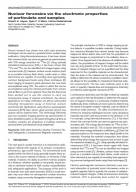Details
- Identification
- ISSN: 1977-5296, DOI: 10.3011/ESARDA.IJNSNP.2019.11
- Publication date
- 1 December 2019
- Author
- Joint Research Centre
Description
Volume: 59, December 2019, pages 21-28,
Authors: Robert B. Hayes, Ryan P. O’Mara, Fatma Abdelrahman
North Carolina State University, Nuclear Engineering Department
Abstract:Recent research has shown how solid state dosimetry techniques can be used as a powerful tool in nuclear treaty verification. Using thermoluminescence, it has been shown that common bricks can serve as gamma ray spectrometers with 10% energy resolution for 241Am [1]. Using optically stimulated luminescence (OSL), it has been shown that 137Cs and 60Co can be identified and imaged again using common bricks [2]. Likewise, surface mount resistors (such as in portable memory flash drives, credit cards or other electronics) are capable of recording dose approaching common background levels using these techniques [3]. Even imaging of weapons grade plutonium has now been accomplished using OSL; the extent to which this can be accomplished using the mineral particulate from smears and air filters is yet to be explored. Now that the theory has been worked out to use this science to carry out retrospective assay of uranium enrichment, the various applications for treaty verification are almost unbounded including retrospective assay of historical uranium enrichment [4]. Applications using electron paramagnetic resonance (EPR) have shown great promise [5] but new options will be explored here. This technology effectively puts low resolution imaging gamma ray spectrometers in every inhabited location on the planet throughout all time as insulator samples are ubiquitous in building materials, personal items and electrical circuit peripherals.
Keywords: Solid state dosimetry; Nuclear Forensics; Nuclear Safeguards; Luminescence; Magnetic resonance.
Reference guideline:
Hayes, R.B., O’Mara, R.P., & Abdelrahman, F. (2019). Nuclear forensics via the electronic properties of particulate and samples. ESARDA Bulletin - The International Journal of Nuclear Safeguards and Non-proliferation, 59, 21-28. https://doi.org/10.3011/ESARDA.IJNSNP.2019.11

